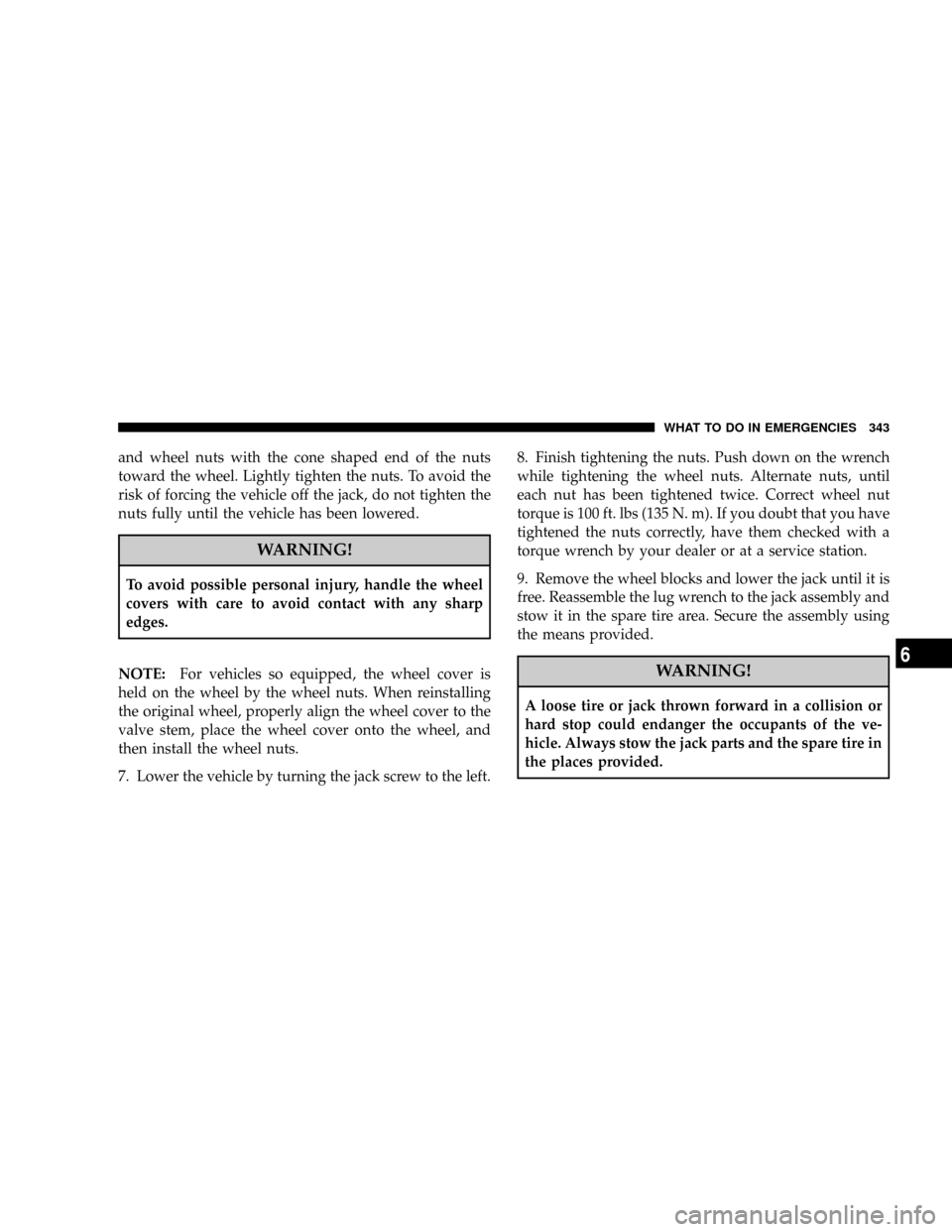2008 CHRYSLER SEBRING CONVERTIBLE ECU
[x] Cancel search: ECUPage 328 of 454

WARNING!
Improper towing can lead to an injury accident.
Follow these guidelines to make your trailer towing
as safe as possible:
Make certain that the load is secured in the trailer
and that it will not shift during travel. When traile-
ring cargo that is not fully secured, dynamic load
shifts can occur that may be difficult for the driver to
control. You could lose control of your vehicle and
have an accident.
²When hauling cargo, or towing a trailer, do not
overload your vehicle or trailer. Overloading can cause
a loss of control, poor performance, or damage to
brakes, axle, engine, transaxle, steering, suspension,
chassis structure, or tires.
²Safety chains must always be used between your
vehicle and trailer. Always connect the chains to the
frame or hook retainers of the vehicle hitch. Cross the
chains under the trailer tongue and allow enough
slack for turning corners.
²Vehicles with trailers should not be parked on a grade.
When parking, apply the parking brake on the tow
vehicle. Put the tow vehicle automatic transaxle in P
for Park. Always, block or9chock9the trailer wheels.
²GCWR must not be exceeded.
²Total weight must be distributed between the tow
vehicle and the trailer such that the following four
ratings are not exceeded:
1. GVWR
2. GTW
3. GAWR
328 STARTING AND OPERATING
Page 342 of 454

CAUTION!
Do not attempt to raise the vehicle by jacking on
locations other than those indicated in step 3.
3. There is one front jacking location and one rear jacking
location on each side of the vehicle. The front locations
are outlined by two triangular cutouts, the rear ones by
two rectangular cutouts. For vehicles equipped with
plastic trim, the plastic has been cut away to expose the
jacking locations in the body.
Do not raise the vehicle until you are sure the jack is
securely engaged.
4. Turn the jack screw to the left until the jack can be
placed under the jacking location. Once the jack is
positioned, turn the jack screw to the right until the jackhead is properly engaged with the lift area closest to the
wheel to be changed. Do not raise the vehicle until you
are sure the jack is securely engaged.
WARNING!
Raising the vehicle higher than necessary can make
the vehicle less stable. It could slip off the jack and
hurt someone near it. Raise the vehicle only enough
to remove the tire.
5. Raise the vehicle by turning the jack screw to the right,
using the swivel wrench. Raise the vehicle only until the
tire just clears the surface and enough clearance is
obtained to install the spare tire. Minimum tire lift
provides maximum stability.
6. Remove the wheel nuts, and pull the wheel and wheel
covers (if equipped) off the hub. Install the spare wheel
342 WHAT TO DO IN EMERGENCIES
Page 343 of 454

and wheel nuts with the cone shaped end of the nuts
toward the wheel. Lightly tighten the nuts. To avoid the
risk of forcing the vehicle off the jack, do not tighten the
nuts fully until the vehicle has been lowered.
WARNING!
To avoid possible personal injury, handle the wheel
covers with care to avoid contact with any sharp
edges.
NOTE:For vehicles so equipped, the wheel cover is
held on the wheel by the wheel nuts. When reinstalling
the original wheel, properly align the wheel cover to the
valve stem, place the wheel cover onto the wheel, and
then install the wheel nuts.
7. Lower the vehicle by turning the jack screw to the left.8. Finish tightening the nuts. Push down on the wrench
while tightening the wheel nuts. Alternate nuts, until
each nut has been tightened twice. Correct wheel nut
torque is 100 ft. lbs (135 N. m). If you doubt that you have
tightened the nuts correctly, have them checked with a
torque wrench by your dealer or at a service station.
9. Remove the wheel blocks and lower the jack until it is
free. Reassemble the lug wrench to the jack assembly and
stow it in the spare tire area. Secure the assembly using
the means provided.
WARNING!
A loose tire or jack thrown forward in a collision or
hard stop could endanger the occupants of the ve-
hicle. Always stow the jack parts and the spare tire in
the places provided.
WHAT TO DO IN EMERGENCIES 343
6
Page 371 of 454

5. Disengage the two retaining tabs that secure the filter
cover to the HVAC housing and remove the cover.
6. Remove the A/C Air Filter by pulling it straight out of
the housing.7. Install the A/C Air Filter with the arrow on the filter
pointing toward the floor. When installing the filter
cover, make sure the retaining tabs fully engage the
cover.
CAUTION!
The A/C Air Filter is labeled with an arrow to
indicate airflow direction through the filter. Failure
to install the filter properly will result in the need to
replace it more often.
8. Reinstall the glove box door dampener and glove box.
Power Steering Ð Fluid Check
Checking the power steering fluid level at a defined
service interval is not required. The fluid should only be
checked if a leak is suspected, abnormal noises are
A/C Air Filter Replacement
MAINTAINING YOUR VEHICLE 371
7
Page 381 of 454

Hoses and Vacuum/Vapor Harnesses
Inspect surfaces of hoses and nylon tubing for evidence
of heat and mechanical damage. Hard or soft spots,
brittle rubber, cracking, tears, cuts, abrasions, and exces-
sive swelling indicate deterioration of the rubber
Pay particular attention to the hoses nearest to high heat
sources such as the exhaust manifold. Inspect hose rout-
ing to be sure hoses do not touch any heat source or
moving component that may cause heat damage or
mechanical wear.
Insure nylon tubing in these areas has not melted or
collapsed
Inspect all hose connections such as clamps and cou-
plings to make sure they are secure and no leaks are
present.
Components should be replaced immediately if there is
any evidence of degradation that could cause failure.
Fuel System
Electronic Fuel Injection high-pressure fuel systems are
designed with tubes and special connects, connections,
and clamps which have unique material characteristics to
provide adequate sealing and resist attack by deterio-
rated gasoline.
You are urged to use only the manufactures-specified
tubes, connections and clamps, or their equivalent in
material and specification, in any fuel system servicing.
Brake System
In order to assure brake system performance, all brake
system components should be inspected periodically.
Suggested service intervals can be found in the ªMainte-
nance Scheduleº in this manual.
MAINTAINING YOUR VEHICLE 381
7
Page 382 of 454

WARNING!
Riding the brakes can lead to brake failure and
possibly an accident. Driving with your foot resting
or riding on the brake pedal can result in abnormally
high brake temperatures, excessive lining wear, and
possible brake damage. You wouldn't have your full
braking capacity in an emergency.
Brake And Power Steering Hoses
When servicing the vehicle for scheduled maintenance,
inspect the surface of the hoses and nylon tubing for
evidence of heat and mechanical damage. Hard and brittle
rubber, cracking, tears, cuts, abrasions, and excessive swell-
ing suggest deterioration of the rubber. Particular attention
should be made to examining those hose surfaces nearest
to high heat sources, such as the exhaust manifold.
Insure nylon tubing in these areas has not melted or
collapsed.Inspect all hose clamps and couplings to make sure they
are secure and no leaks are present.
NOTE:
²Often, fluids such as oil, power steering fluid, and
brake fluid are used during assembly plant operations
to ease the assembly of hoses to couplings. Therefore,
oil wetness at the hose-coupling area is not necessarily
an indication of leakage. Actual dripping of hot fluid
when systems are under pressure (during vehicle
operation) should be noted before a hose is replaced
based on leakage.
²Inspect the brake hoses whenever the brake system is
serviced and at every engine oil change. Inspect hy-
draulic brake hoses for surface cracking, scuffing, or
worn spots. If there is any evidence of cracking,
scuffing, or worn spots, the hose should be replaced
immediately! Eventual deterioration of the hose can
take place resulting in a possibility of a burst failure.
382 MAINTAINING YOUR VEHICLE
Page 432 of 454

About Your Brakes....................264,267
ABS (Anti-Lock Brake System).............. 268
Accessory Delay, Power.................... 12
Adding Engine Coolant (Antifreeze).......... 377
Adding Fuel........................... 316
Adding Washer Fluid..................149,374
Additives, Fuel......................... 310
Air Cleaner, Engine (Engine Air Cleaner Filter) . . . 365
Air Conditioner Maintenance............... 369
Air Conditioning........................ 232
Air Conditioning Controls................. 232
Air Conditioning Filter.................244,370
Air Conditioning, Operating Tips............ 245
Air Conditioning Refrigerant.............369,370
Air Conditioning System.............232,237,369
Air Pressure, Tires....................... 289
Airbag................................ 48
Airbag Deployment...................52,53,56
Airbag Light...................52,53,59,75,177Airbag Maintenance....................... 58
Alarm, Panic............................ 25
Alarm (Security Alarm).................... 18
Alarm System (Security Alarm)............18,177
Alignment and Balance................... 297
Alterations/Modifications, Vehicle............. 7
Antenna, Satellite Radio................... 226
Antifreeze (Engine Coolant)...........376,377,409
Disposal............................ 379
Anti-Lock Brake System (ABS).............. 268
Anti-Lock Warning Light...............268,269
Anti-Theft Security Alarm (Theft Alarm)........ 18
Appearance Care........................ 387
Arming Theft System (Security Alarm)......... 18
Ashtray............................... 163
Audio Systems (Radio).................213,217
Auto Down Power Windows................ 33
Auto Unlock, Doors....................... 31
Auto Up Power Windows.................. 34
432 INDEX
Page 443 of 454

Engine Temperature Warning.............. 178
Exterior.............................. 76
Fog ..........................141,183,403
Hazard Warning Flasher................. 336
Headlight Switch...................138,139
Headlights........................139,401
Headlights On Reminder................. 141
Headlights On With Wipers............139,148
High Beam........................142,401
High Beam Indicator.................... 186
High Beam/Low Beam Select............. 142
Illuminated Entry....................... 20
Instrument Cluster..................... 138
Intensity Control....................... 144
Interior............................. 144
License............................. 407
Lights On Reminder.................... 141
Low Fuel............................ 177
Malfunction Indicator (Check Engine)........ 186Map Reading......................... 144
Oil Pressure.......................... 177
Parade Mode (Daytime Brightness).......... 145
Park.............................138,139
Passing............................. 143
Rear Servicing.....................401,404
Rear Tail............................ 404
Seat Belt Reminder..................... 177
Service...........................400,401
Theft Alarm (Security Alarm).............. 177
Tire Pressure Monitoring (TPMS)........... 299
Traction Control....................... 278
Turn Signal.............76,138,142,183,402,404
Voltage............................. 177
Warning (Instrument Cluster Description)..... 176
Loading Vehicle......................319,321
Capacities........................... 321
Tires ............................... 284
Locks................................. 29
INDEX 443
10